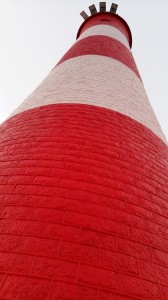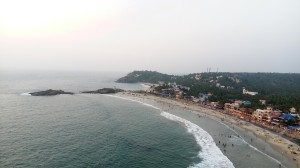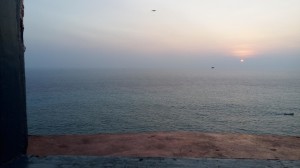It reminds you of a Grimm tale illustration – red and white striped delectable candy on the outside, lurking peril inside. When a ‘revamped’ Kovalam lighthouse – officially Vizhinjam lighthouse, was opened to the public on December 4 last year, I was among the few enthusiastic ones who flocked to applaud the rise of a new genre in tourism – lighthouse tourism. As a global phenomenon, it had been around for some time and had now reached my shores. The whole thing is conceptually heartening and probably the only way forward for these beacons of maritime heritage that are becoming increasingly redundant with improvements in navigational technology.
But the changes made to this lighthouse was more depressing than rebarbative – the glass cage elevator filled up the entire central area totally blocking the view of the iconic 144 steps that spiralled up the 36-metre-high tower. Many moons earlier me and friends have raced up and down these stairs giddy with exertion and other potent ingestibles; we were on photography assignment from our campus nearby. The views from the top would give rise to many verses or picturise those already penned. Still we photographed mostly each other shirtless looking chuffed at our trim bodies. I guess the idea was to use them to get into movie auditions; my mom has kept mine which she employs even today if I refuse my 35th appam. Once you get off the lift now, the final assault to the top still requires you to clamber up a narrow ladder and laboriously emerge from an iron trapdoor. This bit was just like earlier. A short but vertiginous climb where you hauled yourself up rung after rung, clinging to the steel side rails. Understandably the landing was teeming with elderly ones in various stages of terrified rictus, mandibles tracing horrified motions, giving up all hopes of fabulous views affright.
“The lighthouse itself is on a cliff. So, the views from below too will be splendid. Let’s go down.” Said one old man who was shuffling around arthritically.
“Why didn’t you notice that before we bought the ticket?” His wife asked standing squarely by the door blocking others emerging from the busy lift. She, like all wives in long-lasting marriages, was more perturbed by the husband’s lack of fiscal finesse than anything else including daunting plights that lay squarely ahead. Later I saw the husband shuffling around the circular balcony overlooking the magnificent coastline; the wife stayed put below complaining to whoever who asked her to move from the lift how short-sighted her husband was for spending sums without guarantees. I guess the guy, more than enjoying the view up there, was wondering whether to go down at all.
Lighthouses, by dint of their scenic locations, are potential tourism magnets. However, unlike the Tower of Hercules in Spain or the Hook Head in Ireland, Kovalam lighthouse lacks antiquity as it was built in 1972. But it’s flanked by some of the most scenic coastline panoramas in the south of India. On one side are secluded private beaches and rocky promontories that stretch all the way to Vizhinjam where the controversial new port is underway. On the other side you are accorded a bird’s view of the Lighthouse beach itself – the pristine water and the strip of fine sand, dotted by sunbathers in hired decks. Brand Kovalam. People move along the promenade like bees and the stacked hotels like a multi-coloured honeycomb. I stood there for a long time soaking in the view interrupted only by scores of couples who wanted to be clicked together. I obliged happily as a selfie would have limited the endless expanse of an indigo sea spangled by an ochre setting sun.
I met Deepak Kodarkar, the lighthouse in-charge and a grade two navigational assistant. A pleasant Goan, Deepak was teaching the newly appointed ticket collector some basic Hindi words. Chappal utharo. Remove your footwear. ‘Ooth…aaro,’ she said gesticulating with her fingers and giggling. I told Deepak about the peril his charge housed. A mishap is just round the corner, I warned him. A rain will render the ladder slippery and grievous falls cannot be ruled out. Parents watched with their hearts in their mouths as their children gingerly scaled up and scrambled down the cylindrical rungs. An uncle coaxed his thick-glassed nerdy ward without result from above; my own words of encouragement (‘Are you a girl or what?’) were summarily shrugged off.
“It’s good for tourism,” was all Deepak would say. More such fabulous plans were on the way, he told me. The whole area was going to be tiled, landscaped with a garden, play area and a tea stall even. The ticket counter would be shifted to the entry gate – you’d have to pay twenty rupees just to enter the hallowed ground. Deepak seemed visibly pumped up about the whole facelift. He had been the in-charge for seven years now; I could see he was going to be around for another seventy.
India has 189 lighthouses along its 7517 km coastline. The Kovalam lighthouse was just one of the 78 lighthouses earmarked by the Directorate General of Lighthouses and Lightships and the Ministry of Shipping to be developed into tourism destinations in the first phase. Lighthouse tourism breathes new life into structures that would otherwise just corrode under the sea wind and water. But the way it’s underway is shoddy, dangerous, actually. A few days later I managed an appointment with Mrs Mercykutty Amma, state Minister for Fisheries, Harbour Engineering, Cashew Industry and Fisheries University, researching for my #KeralaCoastalWalk I began on January 1 this year.
“Madam, can you stop this abuse of heritage and potential hazard to human life that’s happening in the name of tourism?” I asked her point blank; she struck me as an intelligent woman with warm, compassionate eyes and a blunt, no-frills approach. Being a minister her time was at a premium too – engineers from the harbour engineering department waited patiently for me to finish my run of questions before presenting the blueprint for a mega project, a gamechanger in coastal area transport.
The lighthouse tourism project is a classic case of too many cooks – built by the shipping ministry and the DGLL for tourism purpose on harbour grounds coming under the purview of the ministry for all these and fisheries. Nothing could beat this if inter-departmentality was a contest. Getting answers wouldn’t be so easy however capable the minister was. Besides, there was another minor hiccup:
“I can give you my opinion only after I visit it,” she said.
(This story appeared in Stance magazine, April, 2017 issue.)
















